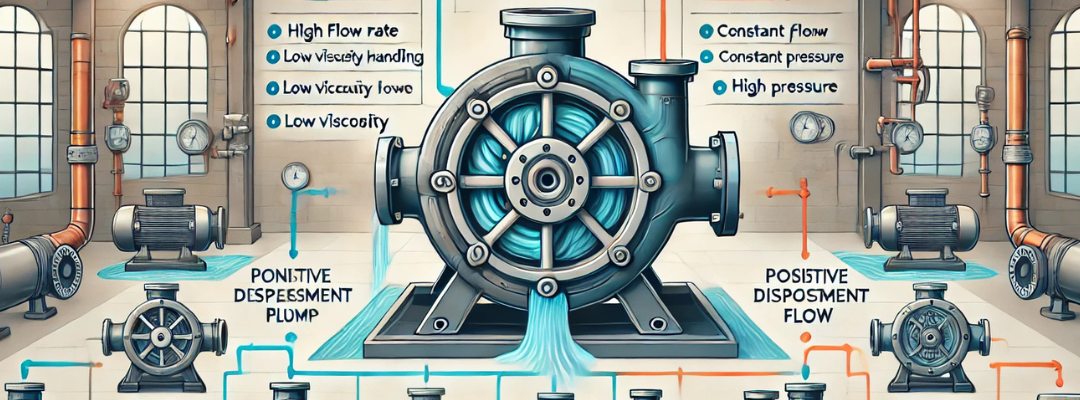Pumps are essential components in industrial, commercial, and residential applications. The two primary categories—centrifugal pumps and positive displacement (PD) pumps—operate on distinct principles, making each suitable for different needs. Understanding their differences will help you choose the best option for your specific use case.
1. Operating Principles: How They Work
Centrifugal Pumps
- Working Mechanism: Converts rotational kinetic energy into hydrodynamic energy. The impeller spins, generating centrifugal force that moves liquid outward and increases its velocity.
- Flow Characteristics: Generates continuous flow but depends on system resistance; flow decreases as pressure increases.
- Best Used For: Low-viscosity fluids requiring steady, high-volume flow.
Positive Displacement Pumps
- Working Mechanism: Traps a fixed volume of liquid in a chamber and mechanically displaces it, creating a constant flow per cycle.
- Flow Characteristics: Consistent flow rate, unaffected by pressure changes.
- Best Used For: Thicker, high-viscosity fluids and applications requiring precise dosing.
2. Flow Rate & Performance Differences
| Feature | Centrifugal Pump | Positive Displacement Pump |
| Flow Rate | Varies with pressure (non-linear) | Constant, pressure-independent (linear) |
| Efficiency | High at optimal speed but drops at high pressures | Efficient across a wide pressure range |
| Handling of Variations | Struggles with viscosity and pressure changes | Maintains flow regardless of system resistance |
| Shear Sensitivity | High shear, can damage sensitive fluids | Low shear, preserves delicate fluid structures |
Which One Is More Efficient?
- Centrifugal pumps perform best when operated at their Best Efficiency Point (BEP).
- PD pumps maintain consistent efficiency even in varying conditions, making them ideal for applications with changing pressures or viscosities.
3. Pressure Handling: High vs. Low Pressure Applications
Centrifugal Pumps
- Designed for low to moderate pressure systems.
- Pressure increases with impeller speed but is limited by system design.
- Common in water distribution, HVAC systems, and irrigation.
Positive Displacement Pumps
- Superior for high-pressure applications (e.g., fuel injection, hydraulic systems).
- Can operate effectively against high resistance without losing efficiency.
4. Handling Different Fluid Types: Viscosity Matters
| Fluid Type | Best Pump Type |
| Low-viscosity (water, alcohol) | Centrifugal Pump |
| High-viscosity (molasses, syrups, slurries) | PD Pump |
| Shear-sensitive (yogurt, emulsions) | PD Pump |
5. Self-Priming Capabilities
Centrifugal Pumps
- Typically not self-priming, meaning they require pre-filling with liquid.
- Some specialized centrifugal pumps have self-priming designs, but they are costlier.
Positive Displacement Pumps
- Naturally self-priming, making them ideal for applications where air pockets or suction challenges exist.
- Used in oil transfer, chemical dosing, and situations where pumps need to handle mixed fluids.
6. Real-World Applications & Industry Use Cases
Centrifugal Pump Applications
- Municipal water supply & circulation
- HVAC systems & cooling
- Irrigation & sprinkler systems
- Fire suppression & emergency water systems
- Industrial processes with low-viscosity fluids
Positive Displacement Pump Applications
- Viscous fluid transfer (oils, slurries, syrups)
- Chemical dosing & metering
- Hydraulic systems & high-pressure applications
- Food & beverage processing (honey, yogurt, dough, emulsions)
- Pharmaceuticals & delicate fluid handling
7. Key Takeaways: Which Pump Should You Choose?
| Need | Best Choice |
| Continuous, high-volume flow | Centrifugal Pump |
| High-pressure system | PD Pump |
| Pumping thick or sticky fluids | PD Pump |
| Low-viscosity fluid transfer | Centrifugal Pump |
| Self-priming needed | PD Pump |
| Energy-efficient under varying conditions | PD Pump |
| Delicate, shear-sensitive fluids | PD Pump |

